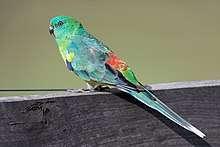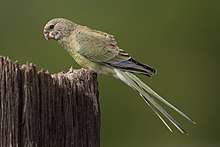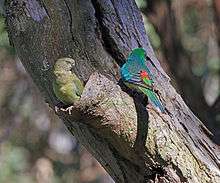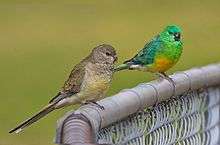Red-rumped parrot
The red-rumped parrot (Psephotus haematonotus), also known as the red-backed parrot or grass parrot, is a common bird of south-eastern Australia, particularly in the Murray-Darling Basin.
| Red-rumped parrot | |
|---|---|
 | |
| Male in New South Wales, Australia | |
 | |
| Female in New South Wales, Australia | |
| Scientific classification | |
| Kingdom: | Animalia |
| Phylum: | Chordata |
| Class: | Aves |
| Order: | Psittaciformes |
| Family: | Psittaculidae |
| Genus: | Psephotus Gould, 1845 |
| Species: | P. haematonotus |
| Binomial name | |
| Psephotus haematonotus (Gould, 1838) | |
| Subspecies | |
|
P. h. caeruleus | |
Taxonomy
The red-rumped parrot was described by John Gould in 1838[lower-alpha 1] as Platycercus haematonotus from a specimen collected in New South Wales. He felt it was intermediate between the genera Platycercus and Nanodes, placing it in the former. He gave it its species name on account of its red rump.[2]
It is the type species for the genus Psephotus. It was long presumed to be closely related to the mulga parrot, however analysis of multiple genetic material shows it to be an early offshoot of a group containing the genera Platycercus and Barnardius.[3][4] Hence all other species in the genus have been moved to the new genus Psephotellus, leaving the red-rumped parrot as the sole member in the now monotypic genus.
The IOC has designated red-rumped parrot as its official common name. It is also known as red-backed parrot and grass parrot.
Description
Red-rumped parrots are slim, moderate-sized parrots approximately 28 cm (11 in) in length. The male's plumage is a bright emerald-green with yellow underparts, a brick-red rump and blue highlights on the wings and upper back. The female's plumage is less vibrant, with pale olive underparts, dull green wings and back and blue-black wingtips. The characteristic red rump is only found in the male.
Behavior

Red-rumped parrots can be found in pairs or flocks in open country with access to water. They avoid the coast and the wetter, more heavily wooded areas. Clearing of large tracts of forest and the provision of water for stock has probably extended their range. They are often seen in suburban parks and gardens. Their green plumage provides such a good camouflage in ankle length grasses that they can hide quite effectively until the viewer is only 10–20 metres away.
They spend a great deal of time feeding on the ground, and often call to one another with an attractive chee chillip chee chillip.
Breeding
Like many parrots, red-rumped parrots nest in tree hollows or similar places, including fenceposts and stumps. They lay 3-6 white eggs, Breeding usually takes place in spring (August to January), however, in the dryer inland areas, breeding can occur at any time of year in response to rainfall.
Aviculture

Red rumps are bred easily in captivity if provided with necessary flight space and a large nesting box. Breeders usually use peat and wood shavings as bedding for the nests, birds like to arrange the beds to their likings. As soon as mating has occurred the hen will deposit 4 to 7 eggs which she will brood for about 20 days. Red rump hens will not go out of the nest box whilst on eggs and not even human checking will make them leave their eggs alone. The eggs will hatch around 30 days after and take care to remove the chicks as soon as they are fledged or else the cock may attack his own offspring. One-year-old birds are already able to breed. Incubation from the second egg onwards. The brooding hen is fed by her partner outside the nest.
Colour mutations have been bred through aviculture. Yellow Red rumped parrots are readily available in the market.
Housing
Red-rumped parrots do well in aviaries and cages. They don't like to be in crowded spaces and will sometimes be aggressive towards other birds if they don't have enough space. Red-rumped parrots can also be hand reared, provided that they have a large cage and are taken out of their cage on a daily basis to prevent boredom, as it may result in the parrot pulling out its feathers to occupy itself.
Lifespan
In captivity, if properly cared for, these birds will live from 15 to 32 years.
Notes
- Although Gould presented the new species in 26 September 1837, the account was not published until 15 February 1838
References
- BirdLife International (2012). "Psephotus haematonotus". IUCN Red List of Threatened Species. 2012. Retrieved 26 November 2013.CS1 maint: ref=harv (link)
- Gould, John (1837). "Proceedings of the Zoological Society of London": 88–89. Cite journal requires
|journal=(help) - Schweizer, Manuel; Güntert, Marcel; Hertwig, Stefan T. (2012). "Out of the Bassian province: historical biogeography of the Australasian platycercine parrots". Zoologica Scripta. 42 (1): 13–27. doi:10.1111/j.1463-6409.2012.00561.x.
- Leo Joseph; Alicia Toon; Erin E. Schirtzinger; Timothy F. Wright (2011). "Molecular systematics of two enigmatic genera Psittacella and Pezoporus illuminate the ecological radiation of Australo-Papuan parrots (Aves: Psittaciformes)". Molecular Phylogenetics and Evolution. 59 (3): 675–684. doi:10.1016/j.ympev.2011.03.017. PMID 21453777.
| Wikimedia Commons has media related to Psephotus haematonotus. |
| Wikispecies has information related to Psephotus haematonotus |
